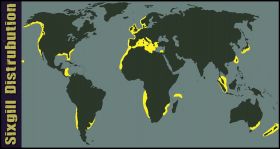The Blunt Nosed Sixgill shark
Hexanchus griseus
The blunt-nosed sixgill shark (often referred to as the six-gilled shark) is larger than any of the other 5 shark species in the order hexacanthiformes, reaching lengths of more than 18 feet.
Distribution and Habitat
The blunt-nosed sixgill shark has a near circumglobal distribution in tropical and temperate waters. However, as it has never been recorded in the extreme deep ocean it is assumed that these sharks require continental shelfs where they can move up and down during the course of a day. This restricts the coastline that the shark is found in. We’ve mapped the areas where the species has been recorded in the distribution map above.
This sixgill shark is known to move up into shallower water to feed at night. During the day it takes refuge in the dark ocean in depths up to 2,500 meters (8,200 feet). The species is also highly migratory and not restricted to a home range.
What do Sixgill Sharks Eat?
Sixgill sharks tend to feed on a wide range of marine organisms. While it readily eats dead pig and horse carcasses from the submarine, its likely to also feed on other sharks, rays, chimeras, bony fish, squids, crabs, shrimp, and even seals. Most of its hunting is likely done in the night.
Life History and Reproduction
Sixgill sharks, as with several other sharks are ovoviviparous, meaning that the mother retains the eggs within her body. The eggs will hatch in her brood chamber, and the young receive nourishment from their yolk sac. They are then born alive.
The gestation time for these sharks is believed to be around 2 years. At that time the mother gives birth to litters ranging from around 22 to 108 pups. These pups emerge at around 60 to 75 cm.
How big are sixgill sharks?
These sharks tend to show a small degree of sexual dimorphism. Female sixgills are much larger with an average size of around 3.5 to 4.2 meters. Males are on average 3.1 to 3.3 meters in length. The largest individuals are upwards of 5.5 meters.
Where can I see sixgill sharks?
In our research and filming trips we have discovered that finding sixgill sharks is extremely rare. However, the following places are your best bets to find sixgill sharks.
Our Sixgill shark Experience
More Six-gilled Shark Videos
This short piece was shot with on Karl Stanley’s submarine for a
This shark footage was taken in Hawaii by researchers on a submarine at 3,300 feet. They have a pair of lasers that can help show the size of the shark. They estimate 18 feet, but this is way to large if you look at the video.
Related Topics
The blunt-nosed sixgill shark (often referred to as the six-gilled shark) is larger than any of the other 5 shark species in the order hexacanthiformes, reaching lengths of more than 18 feet.
Distribution and Habitat
The blunt-nosed sixgill shark has a near circumglobal distribution in tropical and temperate waters. However, as it has never been recorded in the extreme deep ocean it is assumed that these sharks require continental shelfs where they can move up and down during the course of a day. This restricts the coastline that the shark is found in. We’ve mapped the areas where the species has been recorded in the distribution map above.
This sixgill shark is known to move up into shallower water to feed at night. During the day it takes refuge in the dark ocean in depths up to 2,500 meters (8,200 feet). The species is also highly migratory and not restricted to a home range.
What do Sixgill Sharks Eat?
Sixgill sharks tend to feed on a wide range of marine organisms. While it readily eats dead pig and horse carcasses from the submarine, its likely to also feed on other sharks, rays, chimeras, bony fish, squids, crabs, shrimp, and even seals. Most of its hunting is likely done in the night.
Life History and Reproduction
Sixgill sharks, as with several other sharks are ovoviviparous, meaning that the mother retains the eggs within her body. The eggs will hatch in her brood chamber, and the young receive nourishment from their yolk sac. They are then born alive.
The gestation time for these sharks is believed to be around 2 years. At that time the mother gives birth to litters ranging from around 22 to 108 pups. These pups emerge at around 60 to 75 cm.
How big are sixgill sharks?
These sharks tend to show a small degree of sexual dimorphism. Female sixgills are much larger with an average size of around 3.5 to 4.2 meters. Males are on average 3.1 to 3.3 meters in length. The largest individuals are upwards of 5.5 meters.
Where can I see sixgill sharks?
In our research and filming trips we have discovered that finding sixgill sharks is extremely rare. However, the following places are your best bets to find sixgill sharks.
Our Sixgill shark Experience
More Six-gilled Shark Videos
This short piece was shot with on Karl Stanley’s submarine for a
This shark footage was taken in Hawaii by researchers on a submarine at 3,300 feet. They have a pair of lasers that can help show the size of the shark. They estimate 18 feet, but this is way to large if you look at the video.





































































































